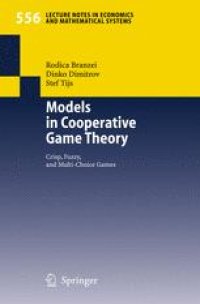
Ebook: Models in Cooperative Game Theory: Crisp, Fuzzy, and Multi-Choice Games
- Tags: Game Theory/Mathematical Methods, Game Theory Economics Social and Behav. Sciences, Operations Research/Decision Theory, Microeconomics
- Series: Lecture Notes in Economics and Mathematical Systems 556
- Year: 2005
- Publisher: Springer Berlin Heidelberg
- Language: English
- pdf
This book investigates models in cooperative game theory in which the players have the possibility to cooperate partially. In a crisp game the agents are either fully involved or not involved at all in coperation with some other agents, while in a fuzzy game players are allowed to cooperate with infinite many different participation levels, varying from non-cooperation to full cooperation. A multi-choice game describes the intermediate case in which each player may have a fixed number of activity levels. Different set and one-point solution concepts for these games are presented. The properties of these solution concepts and their interrelations on several classes of crisp, fuzzy, and multi-choice games are studied. Applications of the investigated models to many economic situations are indicated as well.
This book investigates models in cooperative game theory in which the players have the possibility to cooperate partially. In a crisp game the agents are either fully involved or not involved at all in coperation with some other agents, while in a fuzzy game players are allowed to cooperate with infinite many different participation levels, varying from non-cooperation to full cooperation. A multi-choice game describes the intermediate case in which each player may have a fixed number of activity levels. Different set and one-point solution concepts for these games are presented. The properties of these solution concepts and their interrelations on several classes of crisp, fuzzy, and multi-choice games are studied. Applications of the investigated models to many economic situations are indicated as well.
Content:
Front Matter....Pages I-VIII
Preliminaries....Pages 5-11
Cores and Related Solution Concepts....Pages 13-21
The Shapley Value and the ?-Value....Pages 23-30
Classes of Cooperative Crisp Games....Pages 31-44
Preliminaries....Pages 49-52
Solution Concepts for Fuzzy Games....Pages 53-66
Convex Fuzzy Games....Pages 67-87
Fuzzy Clan Games....Pages 89-100
Preliminaries....Pages 105-107
Solution Concepts for Multichoice Games....Pages 109-119
Classes of Multichoice Games....Pages 121-128
Back Matter....Pages 129-135
This book investigates models in cooperative game theory in which the players have the possibility to cooperate partially. In a crisp game the agents are either fully involved or not involved at all in coperation with some other agents, while in a fuzzy game players are allowed to cooperate with infinite many different participation levels, varying from non-cooperation to full cooperation. A multi-choice game describes the intermediate case in which each player may have a fixed number of activity levels. Different set and one-point solution concepts for these games are presented. The properties of these solution concepts and their interrelations on several classes of crisp, fuzzy, and multi-choice games are studied. Applications of the investigated models to many economic situations are indicated as well.
Content:
Front Matter....Pages I-VIII
Preliminaries....Pages 5-11
Cores and Related Solution Concepts....Pages 13-21
The Shapley Value and the ?-Value....Pages 23-30
Classes of Cooperative Crisp Games....Pages 31-44
Preliminaries....Pages 49-52
Solution Concepts for Fuzzy Games....Pages 53-66
Convex Fuzzy Games....Pages 67-87
Fuzzy Clan Games....Pages 89-100
Preliminaries....Pages 105-107
Solution Concepts for Multichoice Games....Pages 109-119
Classes of Multichoice Games....Pages 121-128
Back Matter....Pages 129-135
....